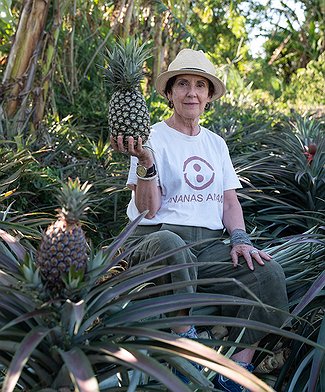INDUSTRY FOCUS: FIBER, YARN AND FABRIC
Emerging as a Stronger Fiber, Yarn and Fabric Business in 2025
Sourcing and textile trade shows held during the first half of 2024 into the summer were packed with apparel professionals seeking fresh innovations and diversification in fiber, yarn and fabrics along their supply chains. Some of these events set attendance records, celebrating the return of loyal exhibitors and visitors while welcoming new associates who presented alternative sourcing options.
The apparel community heads into 2025 with greater global options in sourcing and fresh ideas that will pave the way for a fortified fashion industry.
California Apparel News asked leaders in fiber, yarn and fabric: What have been your greatest supply-chain challenges over the last few years and how are you navigating through them, or have you solved these issues and how have you overcome them?
Nicole Bivens Collinson
Managing Principal, Operating Committee, International Trade and Government Relations Practice Leader
Sandler, Travis & Rosenberg, P.A.
We have worked with several textile and apparel companies during the supply-chain crisis, the imposition of tariffs on the major apparel supplier, China and the implementation of the Uyghur Forced Labor Prevention Act. These actions have forced brands and retailers to know the content of their apparel from “dirt to shirt.”
Companies have been challenged to know their supply chain and get reliable data with bona-fide supporting documentation of the origins of their cotton fiber, yarns and fabrics. The tariffs and the UFLPA shifted significant production out of China into Vietnam, Cambodia and Mexico especially. U.S. Customs and Border Protection, however, has continued to focus on UFLPA enforcement on goods from these countries as well.
Many importers have invested hundreds of thousands of hours in personnel time and monitoring systems to have more visibility throughout the whole supply chain. Systems range from documentation storage to predictive relationship software that CBP may be using and even DNA and isotope testing of apparel products to determine the genesis of the cotton fiber.
Companies that cannot guarantee their tier 2, 3 or 4 suppliers’ goods comply with U.S. law are removed from the chain. Other countries are now implementing similar laws to the U.S. with respect to Chinese cotton, and previous segregation of supply chains for different markets is becoming less effective. In addition, other issues are now creeping into the challenge for sourcing managers as environmental conditions surrounding the manner in which the inputs are sourced and the goods produced are increasing.
Meredith Boyd
Chief Product Officer
UNIFI, makers of REPREVE
One of the greatest hurdles has been the movement of products—both raw materials and finished goods—due to disruptions in global shipping and production slowdowns. This has led to longer lead times, increased and volatile freight costs, and unpredictable delivery schedules.
To navigate these challenges, UNIFI has increasingly focused on leveraging our regional production chains to ensure that customers are quickly able to get the products they need closest to their geographies of production. In regions like the Americas where trade compliance and speed to market is of particular concern, our vertical production has ensured that we can produce key, compliant articles critical to the textile industry as well as for national security.
For our REPREVE recycled polyester production, we carefully manage all processes from incoming waste feedstock to finished yarn including enhanced, functional performance products. This assures our customers where they are choosing our products that they will have consistency and security in supply, quality and pivotal advancements in innovation.
By adopting these strategies, we have become more resilient, building greater flexibility into our operations and those of our customers and reducing vulnerability to global supply-chain disruptions.
Massimo Callegari
North America Manager
ISKO
One of our greatest supply-chain challenges at ISKO has been enhancing sustainability while maintaining style and performance. The shift toward more-sustainable practices involves reducing waste and finding valuable alternatives to virgin materials. This process is complex and requires significant investment in research and development.
Developing new processes and sustainable solutions is not something that happens overnight. It takes years of dedicated effort and innovation to create materials that meet our high standards for both aesthetics and functionality.
ISKO has been working toward sustainability for decades, allowing us to be ahead of the curve in many aspects. By investing in cutting-edge research, collaborating with industry partners and continuously refining our processes, we have been able to overcome many of these challenges.
We have also adopted a circular approach to design, focusing on recycling and reusing materials wherever possible, a case in point being RE&UP. By using next-gen materials to make our fabrics, we reduce waste significantly and create products that are not only stylish and durable but also environmentally responsible.
Joe DiGirolamo
Director of Sales
Thermore
Time heals all wounds, which was our only consolation for things we had no control over like ports opening and closing. But we did implement improvements on the things we did have control over.
In particular, we increased our communications, spent more time forecasting and really focused more on planning in general. That’s paying off even though, now, our supply-chain movement is back to pre-pandemic functioning.
Andreas Dorner
General Manager
RE&UP
One of the greatest challenges we face at RE&UP is navigating the complexities of the recycling industry, which is driven by innovation but often progresses through trial and error. The recycling of textiles, in particular, has significant logistical and technological limitations. In 2023 alone, over 100 million tons of textile waste were generated globally, yet only 1 percent of this waste was recycled. Nearly 90 percent ended up in landfills or was incinerated.
This alarming scenario, where planet conservation and resource preservation are at critical risk, poses a significant challenge that the textile industry cannot ignore. As a society, we owe it to ourselves to do better. With increasingly stringent legislations and policies being implemented in this field, it is imperative that we act now to develop sustainable solutions.
Being part of Sanko, a group with a 120-year history, provides us with the knowledge, technology and global reach necessary to address these challenges effectively. Leveraging this experience, we are committed to developing processes that truly change the industry paradigm. Our aim is not just to innovate but to also create scalable, sustainable practices that can be adopted across the globe. The time is ripe for change, and the industry is ready to collaborate.
Raissa Hannon
Sales Manager and Print Designer
Kalimo
One of the most significant challenges we’ve faced in our supply chain has been the sharp increase in materials pricing. To effectively tackle this issue we’ve shifted our focus toward identifying and forming strategic partnerships with local supply sources.
This approach has proven to be highly effective as it allows us to manage better and mitigate the impact of fluctuating prices and helps us uphold a consistent cost structure for our clients. We’ve been able to ensure that there are no unexpected price differences during our clients’ production processes. Additionally, this strategy enables us to maintain the same reliable delivery times for their fabric orders. These efforts have been instrumental in preserving our clients’ trust and satisfaction, reinforcing our commitment to delivering high-quality fabrics and providing stable and dependable service amid a challenging market environment.
Dr. Carmen Hijosa
Founder and Piñatex Inventor
Ananas Anam
Our most significant supply-chain challenge has been establishing the supply chain itself. As specialists in producing textiles from waste pineapple-leaf fiber, a material that has only recently gained traction in commercial use, we faced the task of building much of the supply chain from the ground up. Collaboration has been key, and it has been critical to work with those specialized in the area of natural fibers.
However, this challenge has also presented us with a substantial advantage. It has allowed us to carefully select partners who align with our values and ethos, ensuring close collaboration at every stage. While building our supply chain from scratch, we have benefited from this close collaboration across the supply chain to ensure that our materials are produced using the most efficient methods available.
A key benefit of building the supply chain from such an early stage is that we have achieved greater traceability for our products, having worked closely with everyone from our partner farms all the way to our manufacturing partners.
Michelle Lea
Chief Marketing and Sustainability Officer
NILIT
During the past few years accelerating sustainability and reducing our environmental impact have been imperatives for NILIT. We became laser focused on both product development and process improvement to rapidly enhance our internal performance as well as the premium Nylon 6.6 products we craft for our mills, brands and retailers. Our most recent Impact Report documents the environmental goals we have achieved as well as our priorities for the future. Our SENSIL product portfolio has grown significantly to include many new products that address textile-specific environmental concerns such as expanding recycled content, reducing waste and emissions, preserving water, and increasing apparel circularity.
We have made great strides through collaboration with our employees and supply-chain associates as well as with pioneering partnerships that create more-sustainable options for our customers. We recently announced our partnership with Samara Eco, the Australian enviro-tech innovator, to establish a state-of-the-art Nylon 6.6 textile-to-textile enzymatic recycling facility in Southeast Asia. This partnership will ramp up Nylon 6.6 recycling to make a substantial impact on the industry’s use of recycled content, reducing reliance on virgin materials and providing a more beneficial alternative for the incredible volume of apparel that is discarded in landfills each year.
Chris Leyes
Chief Operating Officer
Cocona Labs | 37.5 Technologies
The greatest supply-chain challenges we have encountered over the last few years were mainly due to COVID-related factory closures, raw material availability, extended lead times and the movement of freight around the world. We addressed these issues through working tirelessly with our supply-chain partners to ramp up capacity.
We also invest in the buildup of an extremely robust raw material, work in the process and finished goods inventory pipeline, and establish partnerships with several Free Trade Zone Warehouses in the key geographic regions around the globe in which we operate.
Dave Maslen
Chief Customer Officer
The New Zealand Merino Company
Through our ethical and traceable wool programs, ZQ and ZQRX, we hold strong relationships at every stage of the supply chain—from fiber to finished product. While essential for preserving the integrity and value of our wool, these connections really show their power in challenging times.
Brands with decades—or centuries—of experience struggled to predict their fiber needs during COVID. We shifted very quickly from the immediate post-COVID period with companies throughout the value chain struggling for materials to the oversupply we’re still managing today.
Closer to home, our growers are also battling global economic pressures with the added stress of being small family-owned businesses. No one has come away unscathed; however, working with brands, supply-chain partners and growers that value deep bonds and partnerships over surface-level transactional relationships has been part of the solution.
We have relieved overcommitted brands by shifting fiber to other contracts. We’ve worked with existing supply-chain partners and onboarded new ones to increase the volume of ready-to-use ZQ and ZQRX fabric and yarn available quickly for designers. Crucially, we’ve worked with our grower community to preemptively manage our supply while it’s still on the sheeps’ backs.
Mustafain Munir
President
CYCLO
In Bangladesh, rising energy costs and an inconsistent power supply have been our biggest challenge. We have invested in renewable-energy solutions to stabilize power costs and improve sustainability; however, the inconsistency issue will prevail until the national power supply increases and stabilizes.
The rise in misleading environmental claims and fraudulent certified material has led to decreased customer trust and decreased selling prices as recycled cotton and other sustainable materials are competing more directly with virgin/non-sustainable materials that are wrongfully certified. An increase in overall transaction certificates caused a backlog and delays in issuance.
In response, we have strengthened our traceability and transparency efforts through blockchain-based digital passports such as AWARE and engage in partnerships such as Textile Exchange and Fashion For Good.
Shipping delays from China have led to inventory shortages specifically for synthetic fibers. We have increased order allocation to more expensive local producers and are working with them to diversify their product range.
The rise in interest rates has significantly raised the cost of borrowing, causing liquidity issues that affect our ability to secure materials in bulk at competitive prices, delaying orders further.
David Sasso
Market Consultant
Buhler Quality Yarns
Buhler and Samil Spinning’s greatest challenge has been unpredictable demand. This issue is larger than any single company can solve, but there are ways to cope with this problem.
Increases in flexibility with lower minimum order quantities and enhanced fiber-processing capabilities allow for more agile response to fluctuating demand.
An expanded business approach looks beyond direct customers. Selling as a supply chain rather than just a spinner affords a more holistic view of the market and new opportunities.
Focus on innovation creates value and excitement through new products. Innovation in many cases does not have to lead to lower pricing. This strategy aims to differentiate the company and potentially create demand rather than just responding to it.
Carolina Sister Cohn
Global Marketing Leader for Textiles
Naia Eastman
Naia from Eastman was born in 2019. The biggest challenges came from the complexity of educating the industry—from supply-chain partners to brands and end consumers—about the transformative potential of innovative, sustainable materials, especially in the initial phase of our journey.
To overcome these obstacles, we have emphasized transparency and certifications, which validate our sustainable practices and build trust in the supply chain. Collaborations with mills, brands and designers are key and allow us to communicate our story directly to consumers. By partnering with brands, we ensure that our fibers, such as the GRS-certified Naia Renew, integrate seamlessly into collections, allowing us to tell a complete sustainability story that resonates with consumers. We also support educational initiatives such as working with design schools to foster a deeper understanding of sustainable textile solutions among future designers. This approach helps create a ripple effect throughout the industry, making responsible fashion accessible to all and gradually shaping a more sustainable and transparent textile industry.
Tina Stridde
Managing Director
Aid by Trade Foundation
Demand is growing for textile raw materials whose origins can be traced seamlessly along the entire value chain. Transparency is the order of the day to comply with legal requirements at the international level as well as to meet the demands of an increasing number of consumers.
The success of our sustainably verified cotton and cashmere fibers confirms this trend. We are making an essential contribution to the transformation of raw-material and textile production. This success is no accident. Transparency is the fundamental principle of the AbTF standards. Our corporate partners can be assured that fibers verified in accordance with Cotton made in Africa, The Good Cashmere Standard or the new Regenerative Cotton Standard meet the highest requirements.
In addition to independent third-party audits at the raw-material production level, we also ensure full transparency in the supply chain. For CmiA and RCS cotton, the Hard Identity Preserved system guarantees complete traceability back to the growing region based on the Sustainable Cotton Tracker system. The platform from TextileGenesis ensures the correct further processing of GCS cashmere, enabling every order to be traced back to the producer. DNA markers developed by Haelixa provide another option for reliably identifying the GCS-verified fibers in the product.
The comprehensive transparency ensured in this way guarantees that yarns, fabrics or textiles only contain verified fibers of our standards. Only textiles produced with these fibers may ultimately bear the CmiA, GCS or RCS logos.
Katie Tague
Senior Vice President of Global Marketing and Sales
Artistic Milliners
One of our significant initiatives to address the challenges of the last few years is the concept of nearshoring. We have strategically established production facilities closer to our main markets such as the Star Fades International wash-and-finishing facility in L.A. and the recent acquisition of VF’s Dickies de Parras S. de RL de CV facility in Parras, Mexico.
By having production facilities in close proximity to our main markets, we have enhanced agility and responsiveness, reduced transportation costs, and improved overall efficiency. These facilities have allowed us to streamline processes, manage inventory more effectively and meet customer demand in a timely manner.
Furthermore, we have invested in technology and digital solutions to enhance visibility and transparency across our supply chain. Real-time tracking systems and data analytics have enabled us to optimize operations, minimize disruptions and ensure a resilient supply-chain network.
Andrea Venier
Managing Director
Officina39
Around two years ago we faced a raw-materials crisis coupled with a sharp rise in transportation, packaging and energy costs. These pressures were entirely new for us, and we had to adapt quickly. Logistics remains a major challenge, particularly with ongoing disruptions like the Red Sea closure, which continues to put pressure on our operations. We operate in a complex, interconnected yet fragile world where even small events can have far-reaching impacts—the ripple effect. To address these challenges, we’ve focused on improving our planning across raw materials, production and logistics. This has been key to navigating the difficulties of recent years.
We need to develop a new model that restores balance. While this transition will be challenging and will certainly have significant consequences for the industry, it also presents an opportunity. It’s a challenge that must be met with awareness and a shift in perspective, one that prioritizes available resources and real needs. Our goal is to be part of this change, and we are continuously working to make a meaningful contribution to this transformation.
MeiLin Wan
Vice President of Textile Sales
Applied DNA Sciences, Inc.
Ongoing disruptions in global shipping have led to delays, impacting delivery schedules and potentially leading to inventory shortages or production delays. Lack of available shipping containers has exacerbated delays and added logistical complexity, affecting our ability to transport goods efficiently. Increases in shipping costs over the past few years are likely to continue, placing additional financial strain on operations and impacting pricing strategies.
Partnering with established groups like Indus Apparel enables us to leverage their existing infrastructure and market presence in regions like Pakistan, Egypt and Jordan. This can help reduce reliance on long-distance shipping and minimize delays.
By working closely with in-country partners, we are better positioned to handle local challenges, streamline logistics and respond more rapidly to market demands. This localized approach can also lead to cost savings and more-efficient supply-chain management.
Deploying our CertainT Traceability Platform globally and at scale with major players in the cotton industry provides a strong proof point for our technology solutions. By offering DNA tagging, isotope and genomic testing, we provide a one-stop-shopping solution that helps clients be more efficient and responsive in spite of supply-chain challenges.
Sherry Wood
Director of Merchandising & Design
Laguna Fabrics
Laguna has shifted to multisourcing strategies and built more regional supply chains. We are reacting to market trends and continue to provide our brands with quick deliveries and competitive pricing. We are also leveraging real-time tracking and inventory management as erratic shifts in consumer demand during the pandemic led to overstocking or understocking issues.
Laguna is investing in forecasting tools, enabling greater flexibility and adaptability to changing consumer patterns. Laguna is focused on a more-sustainable and transparent supply chain working with our brands to comply with environmental and ethical standards. We are working on greener logistics, reducing our carbon footprint and adopting circular supply-chain practices. Being a domestic mill enables us to avoid many of these supply-chain challenges, which is a great benefit for our brands. Laguna will continue bringing innovation, better data visibility and planning to overcome any future disruptions.
*Responses have been edited for clarity and space.








































